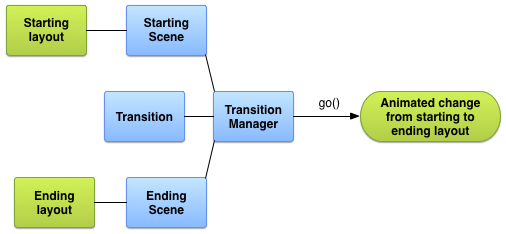Building Apps with Graphics & Animation
Displaying Bitmaps Efficiently
- 手机内存资源有限,一个应用最少可能只有16MB的内存
- 使用Bitmap显示图片,如果不压缩,很可能一个图片就会占用十几MB的内存
- ListView, GridView, ViewPager这种View,可能显示在屏幕上的只有几个图片,但是还有很多是没有显示在屏幕上的,如果没有显示在屏幕上的也占用着内存,那将很快导致OOM
在解码/载入图片到内存(Bitmap对象)之前,要先判断一下图片的尺寸,获取图片的尺寸和类型:
BitmapFactory.Options options = new BitmapFactory.Options(); options.inJustDecodeBounds = true; BitmapFactory.decodeResource(getResources(), R.id.myimage, options); int imageHeight = options.outHeight; int imageWidth = options.outWidth; String imageType = options.outMimeType;设置
options.inJustDecodeBounds = true,将只读取文件信息,不会为图片分配内存载入和屏幕尺寸适配的图片尺寸,否则空占内存却没有视觉效果的提升,需要考虑以下因素:
- 预计完全载入图片所需的内存大小
- 预期为加载此图片愿意分配的内存
- 用来显示该图片的View的尺寸
当前设备的屏幕尺寸和像素密度
public static int calculateInSampleSize( BitmapFactory.Options options, int reqWidth, int reqHeight) { // Raw height and width of image final int height = options.outHeight; final int width = options.outWidth; int inSampleSize = 1; if (height > reqHeight || width > reqWidth) { final int halfHeight = height / 2; final int halfWidth = width / 2; // Calculate the largest inSampleSize value that is a power of 2 and keeps both // height and width larger than the requested height and width. while ((halfHeight / inSampleSize) > reqHeight && (halfWidth / inSampleSize) > reqWidth) { inSampleSize *= 2; } } return inSampleSize; } public static Bitmap decodeSampledBitmapFromResource(Resources res, int resId, int reqWidth, int reqHeight) { // First decode with inJustDecodeBounds=true to check dimensions final BitmapFactory.Options options = new BitmapFactory.Options(); options.inJustDecodeBounds = true; BitmapFactory.decodeResource(res, resId, options); // Calculate inSampleSize options.inSampleSize = calculateInSampleSize(options, reqWidth, reqHeight); // Decode bitmap with inSampleSize set options.inJustDecodeBounds = false; return BitmapFactory.decodeResource(res, resId, options); } ... mImageView.setImageBitmap( decodeSampledBitmapFromResource(getResources(), R.id.myimage, 100, 100)); ...
加载、处理图片要在非UI线程执行,使用rx可以方便地做到这一点
- 缓存Bitmap
- 内存缓存:LruCache,放入cache的要用SoftReference或者WeakReference,以免放入缓存的数据未被按时移出缓存,导致内存泄漏
- 磁盘缓存:DiskLruCache,;当要缓存的数据经常被访问时,使用ContentProvider会更合适
- 响应Configuration change:使用headless fragment,是实现方式之一
- 管理bitmap内存
- API <= 10:当确定bitmap不会被使用之后,调用bitmap.recycle()
- API >= 11:
BitmapFactory.Options.inBitmap,会使得bitmap mutable,不太建议使用
- 显示bitmap,将资源加载到内存的过程要在非UI线程执行,避免程序未响应
Displaying Graphics with OpenGL ES
- Transitions Framework原生API支持,需要API >= 19, Animations backported to Android 4.0+. API compatible with Android 2.2+
The Transitions Framework
- 动效的意义:帮助用户理解app的行为,理解视觉变化的意义
- 包含的功能
- Group-level animations:可以应用于整个View hierarchy
- Transition-based animation:基于property animation
- Built-in animations:内置了很多动效实现
- Resource file support:支持在xml中定义动效
- Lifecycle callbacks:具备生命周期回调,便于响应动效状态进行逻辑操作
- 原理

- Scene
- 记录View hierarchy的状态
- 支持从xml创建/从ViewGroup对象创建
- 通常不需要显式指定开始的Scene,默认是前一个ending Scene,或者当前屏幕上显示的view hierarchy
- Scene的转化都发生在同一个Scene root中
- Transition
- 在动效框架中,通过把scene的变化转化为一系列的关键帧,动画的信息保存在Transition对象中,通过TransitionManager来播放动画
- 可以为两个Scene创建动画,也可以为当前Scene的不同状态创建动画
- 内部实现了常用的动效:fading, resizing...
- Limitations
- 对SurfaceView应用动效可能不会正常显示,SurfaceView在非UI线程进行更新
- 有些动效可能对TextureView无效
- 对AdapterView(例如ListView)使用动效,可能会导致界面卡住
- 对TextView使用resize动效时,文字可能会在动效完成之前先“弹”出去,所以避免对有文字的view使用resize动效
Creating a Scene
从xml创建
scene root
<FrameLayout android:id="@+id/scene_root"> <include layout="@layout/a_scene" /> </FrameLayout>starting scene
<LinearLayout xmlns:android="http://schemas.android.com/apk/res/android" android:id="@+id/scene_container" android:orientation="vertical" android:layout_width="match_parent" android:layout_height="match_parent" > <TextView android:id="@+id/text_view1 android:text="Text Line 1" /> <TextView android:id="@+id/text_view2 android:text="Text Line 2" /> </LinearLayout>ending scene
<LinearLayout xmlns:android="http://schemas.android.com/apk/res/android" android:id="@+id/scene_container" android:orientation="vertical" android:layout_width="match_parent" android:layout_height="match_parent" > <TextView android:id="@+id/text_view2 android:text="Text Line 2" /> <TextView android:id="@+id/text_view1 android:text="Text Line 1" /> </LinearLayout>创建scene
Scene mAScene; Scene mAnotherScene; // Create the scene root for the scenes in this app mSceneRoot = (ViewGroup) findViewById(R.id.scene_root); // Create the scenes mAScene = Scene.getSceneForLayout(mSceneRoot, R.layout.a_scene, this); mAnotherScene = Scene.getSceneForLayout(mSceneRoot, R.layout.another_scene, this);代码创建
Scene mScene; // Obtain the scene root element mSceneRoot = (ViewGroup) mSomeLayoutElement; // Obtain the view hierarchy to add as a child of // the scene root when this scene is entered mViewHierarchy = (ViewGroup) someOtherLayoutElement; // Create a scene mScene = new Scene(mSceneRoot, mViewHierarchy);Create Scene Actions
- 当涉及的View不在同一个view hierarchy中时,可以通过创建scene action来辅助实现动效
- 动效框架无法自动创建scene action时,可以手动创建,例如ListView
- 把要执行的操作封装到Runnable中,设置给
Scene.setExitAction()和Scene.setEnterAction() - 注意:不要在scene action中传递数据
应用动效
- 内置动效
- AutoTransition/<autoTransition/>:Default transition. Fade out, move and resize, and fade in views, in that order.
- Fade/<fade/>:fade_in fades in views; fade_out fades out views; fade_in_out (default) does a fade_out followed by a fade_in.
- ChangeBounds/<changeBounds/>:Moves and resizes views.
从xml创建
res/transition/fade_transition.xml
<fade xmlns:android="http://schemas.android.com/apk/res/android" />inflate
Transition mFadeTransition = TransitionInflater.from(this). inflateTransition(R.transition.fade_transition);代码创建:
Transition mFadeTransition = new Fade();- 应用动效:
TransitionManager.go(mEndingScene, mFadeTransition); - 支持只对view hierarchy中的部分view应用动效:
removeTarget(),addTarget() 同时使用多种效果:TransitionSet
在res/transitions/目录下创建资源文件
<transitionSet xmlns:android="http://schemas.android.com/apk/res/android" android:transitionOrdering="sequential"> <fade android:fadingMode="fade_out" /> <changeBounds /> <fade android:fadingMode="fade_in" /> </transitionSet>不使用Scene而直接应用动效
- 通过removeView/addView来改变view hierarchy, 并使用delayed transition
- 改变view hierarchy之前调用TransitionManager.beginDelayedTransition()
- 修改view:增/减/改
- 实现TransitionListener以在动效生命周期回调中执行操作
- 内置动效
自定义Transition
继承Transition类
public class CustomTransition extends Transition { @Override public void captureStartValues(TransitionValues values) {} @Override public void captureEndValues(TransitionValues values) {} @Override public Animator createAnimator(ViewGroup sceneRoot, TransitionValues startValues, TransitionValues endValues) {} }Capture View Property Values
captureStartValues
scene中的每个view都会调用一遍,TransitionValues包含view对象,和一个map,用于记录view对象的各个感兴趣的属性值
```java public class CustomTransition extends Transition {
// Define a key for storing a property value in // TransitionValues.values with the syntax // package_name:transition_class:property_name to avoid collisions private static final String PROPNAME_BACKGROUND =
"com.example.android.customtransition:CustomTransition:background";@Override public void captureStartValues(TransitionValues transitionValues) {
// Call the convenience method captureValues captureValues(transitionValues);}
// For the view in transitionValues.view, get the values you
// want and put them in transitionValues.values
private void captureValues(TransitionValues transitionValues) {
// Get a reference to the view
View view = transitionValues.view;
// Store its background property in the values map
transitionValues.values.put(PROPNAME_BACKGROUND, view.getBackground());
}
...
}
```
+ `captureEndValues`和`captureStartValues`类似
```java
@Override
public void captureEndValues(TransitionValues transitionValues) {
captureValues(transitionValues);
}
```
createAnimator,transition framework调用此函数的次数与scene的变化有关- 例如5个view,变化后有2个被移除,1个新加入,则会调用6次:3个保持存在,2个移除,1个加入;
- 保持存在的view,调用时两个TransitionValues都不为null,而只存在于一个状态的,另一个状态对应的TransitionValues参数为null;
- 最终利用两个TransitionValues参数,返回一个property animator
Adding Animations
- 交叉隐现
View.animate()方法返回ViewPropertyAnimator对象,对其可以进行各种property animation
ViewPager的使用- 通常结合
Fragment使用 - 和
ListView类似,ViewPager也需要一个Adapter,FragmentStatePagerAdapter的实现类 - ViewPagerIndicator
- 实现
ViewPager.PageTransformer接口,通过其transformPage函数自定义page切换动效position参数表示当前page的位置- 小于0表示位于屏幕中心点左侧
- 小于-1表示完全移出了屏幕
- 大于0表示位于屏幕中心点右侧
- 大于1表示完全移出了屏幕
- ViewPagerTransforms, VerticalViewPager
- 通常结合
- Displaying Card Flip Animations
- 为FragmentTransition设置过场动效:
setCustomAnimations,注意:这个函数的调用顺序很重要,一定在add,replace等操作之前。
- 为FragmentTransition设置过场动效:
- Zooming a View
- 示例演示了组合使用
ObjectAnimator来实现缩略图放大到大图的动画效果,以及反向效果。
- 示例演示了组合使用
- Animating Layout Changes
- 使用
setLayoutTransition()设置自定义layout变化动效 - 新的
Scene框架也可以做这个事情 - back-port的transition everywhere库也有相应接口:
TransitionManager.beginDelayedTransition(ViewGroup)
- 使用
- 更多,安卓系统动效专题